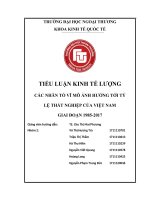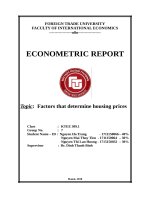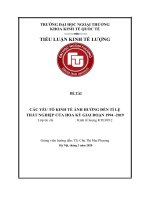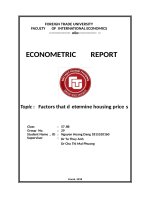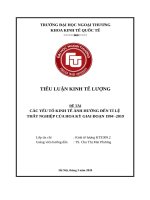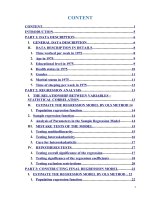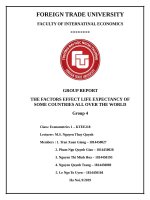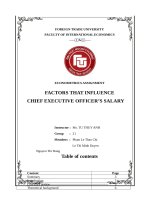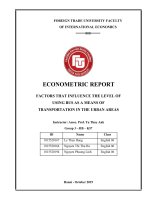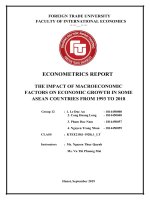tiểu luận kinh tế lượng FACTORS THAT INFLUENCE CHIEF EXECUTIVE OFFICER SALARY
Bạn đang xem bản rút gọn của tài liệu. Xem và tải ngay bản đầy đủ của tài liệu tại đây (437.26 KB, 31 trang )
FOREIGN TRADE UNIVERSITY
FACULTY OF INTERNATIONAL ECONOMICS
-----&-----
ECONOMETRICS ASSIGNMENT
FACTORS THAT INFLUENCE
CHIEF EXECUTIVE OFFICER’S SALARY
Instructor : Ms. TU THUY ANH
Group
: 21
Members : Pham Le Thao Chi
Le Thi Minh Duyen
Nguyen Thi Dung
Table of contents
Content
Summary
Introduction
Literature review
Theoretical background
Page
3
3
5
6
Descriptive statistic of data
Econometrics model
Robustness check
Finding and discussion
Conclusion
Reference
Appendix
7
8
9
10
-
Summary
The essay examines the factors affecting salary for the Chief Executive Officer
(CEO) of which the data is collected from random samples reported in Businessweek
by Wooldridge
The objective of this paper is to define the relationship between a set of factors and
CEO compensation that will enable companies to imply better corporate governance practices
in their management process. Developed econometric model is tested on the data which
focusee mainly on the CEO salaries of industrial firms that have been vastly
successful, along with CEO of large financial firms . The study revealed that CEO
compensation is strongly and positively related to revenue and return on equity of the
2
company, and unrelated to return of stock or types of firms. These results enable companies
to use CEO compensation system as an effective mechanism to eliminate agency problem
and, consequently, agency costs.
Introduction
In the current market economy, human resources are always an important factor
for the success of each company. In order to develop your company, managers need to
motivate their employees through their needs, interests, passion, enthusiasm ... One of
the most important way to create motivation is paying salary for workers and
company executive board. Moreover, the chief executive officer (CEO) is also a hired
labor but he/she has the highest-ranking in a company because of having ultimately
responsible for making managerial decisions. Because the CEO plays a such special
important role to the company's operations, there has been a debate over the issue
whether the CEOs are now paid appropriately and aligned with their contribution and
how to pay them rationally is always a challenge for companies. In our report, we will
focus on the analysis of CEO’s salary to clarify the issue.
The salary of the CEO has been attracting attention of researchers. The
researchers suppose that the salary information for the CEO brought by the salary
database system and be public. That’s why it is competitive and how easy that a CEO
can move from one firm to another to get a higher position or higher compensation.
Therefore, the CEO’s salary has generated a large number of studies on this area. The
most discussed topics salary for the CEO is the analysis factors affecting salary for
CEOs. And this also is the objective of this essay.
Data and analysis on this relation will enhance the knowledge on the role of
different factors that may influence the managerial performance and help identify the
trends of organizational performance for all the firms in the industry. There are a lot of
papers, that will be examined further, that analyze different industries from the point
of view of salary system. In this paper we decided to focus on industry firm and
financial firm as previous researchers did not analyze this industry in details and that
brings novelty to the paper.
3
We will define the main factors that influence CEO’s salary. It is assumed that
the evidence of this research will fulfill the literature gap that exists now in the field of
the relation between salary and accounting and market measures; will enhance the
knowledge on the role of different factors that may influence the managerial
performance and help identify the trends of organizational performance for all the
firms.
The essay is organized in the following way: The first part provides a
theoretical background on the topic. The second part represents methodology
overview and the regression model used in the paper. In the last part the conclusions
and managerial applications are discussed. Literature review on the topic will show
that the pay-performance topic has been investigated a lot from different perspectives.
We are members of group 21 and our group have worked hard to complete this
project:
1.
Pham Le Thao Chi
ID: 17155200
2.
Le Thi Minh Duyen
ID: 1715520016
3.
Nguyen Thi Dung
ID: 1715520014
We are willing to receive your comments to improve our knowlegde and skill.
Thank you for giving us the nice and useful lessons through our Econometrics course
and spending time to consider this study.
Literature review
Nowadays a lot of attention has been paid to executive compensation as to an
effective mechanism of corporate governance and in particular of agency problem.
Properly awarded executive in most cases does not have an incentive to operate in
self-interest and act irresponsibly, but maximization of the company’s value. Thus the
main objective of this paper is to identify the set of factors that influence the executive
compensation on the example of industry nowadays.
Up to the present moment huge amount of researches investigated that payperformance relationship is connected with the fact that there is no common approach
4
which could enable to evaluate the quality of corporate governance in a company.
Thus, all the existed research could be divided into four main groups.
The first group is the most valuable for current empiric research. It considers
the correlation between the executive compensation and performance of the company.
The researches include analysis which is also based on market, accounting and cost
measures. In this group the researches investigate the influence of economic value
added and market value added on the executive compensation.
The field really took off with the work of Murphy (1985) who considered the
panel data on compensation of individual executives and performance over the
number of years. He introduced “fixed-effects models” and considered the effects of
six performance-sensitive components of remuneration (salary, bonus, option awards,
deferred compensation, value of stock options, total compensation). Overall he
documented that compensation is strongly positively related to corporate performance
as measured by shareholder return and growth in firm sales. Hall and Liebman (1998)
conducted a research identifying the strong link between wealth and firm
performance. They also pointed out that the relationship is very sensitive so that small
changes in performance can have large effects on the lifetime wealth of an executive
(Florin, Hallock and Webber 2010).
Another perspective on the role of executive compensation in agency theory is
considered in the works of Hambrick and Finkelstein (1995). They argue that the
relationship between the compensation and company’s performance is necessary for
explaining the hidden parts of compensation. Beer and Katz (1998) revealed the
results of research devoted to executive compensation. The research documented that
the average salary in American corporations is much higher than the remuneration in
Asian or European ones and has a positive impact on managers’ behavior. For current
research the peculiarities of American companies are of great importance. It is unique
due to the fact that option awards are the biggest part of compensation. That means
that the level of executive remuneration is much higher than the level of general
employee.
5
All these results enabled researches to do a major conclusion that the more
executive compensation is dependent on the performance of the company. Most
studies that explore the pay-performance relationship used the accounting-based
measures of corporate performance, i.e. ROA or ROE. However the trend is shifting
nowadays and more and more studies use risk adjusted firm-performance – market
value added. Corporate governance is of paramount importance for every
organization. History has revealed that there is never-ending evolution of corporate
governance and its fundamental theories. Companies strive for good corporate
governance practices as a yardstick for strategic development of a company.
After conducting research, many authors stress the importance of firm specific
characteristics as a determining factor of the CEO’s salary. Firm’s size is argued to be
the most important characteristic. In this respect, a meta-analysis of Tosi, Werner, Katz
and GomezMejia (2000) demonstrates that firm’s size accounts for over 40% of the
variance in CEO pay, whereas firm’s performance contributes less than 5%. This
analysis used empirical evidence of 105 studies on the relationship between managers’
salary and firm performance. Earlier, Finkelstein and Hambrick (1988) as well
concluded that firm’s size accounts for the greatest proportion of variance in the
executive compensation level while firm’s performance accounts for very little.
Managers of larger firms need to be rewarded for the greater complexity and risk
according to the literature. Higher wages need to be offered in order to attract highquality managers that are demanded in firms with greater complexity and risk (Core,
Holthausen, & Larcker, 1999). Furthermore, the relationship between the use of debt
financing and the salary of the CEO is expected to be negative (Alves et al., 2016).
Besides the fact that debt may positively influence firm’s performance due to the
advantage of tax deductible interests (Lubatkin & Chatterjee, 1994), it can reduce
agency costs since the cash flow of the firm – that can be used for spending by
managers – is reduced (Jensen, 1986). Consequently, the ability of the CEO to extract
extra rents form the firm is reduced as well. A final firm specific factor is whether the
company is regulated or not. In regulated firms, CEOs earn less compared with
unregulated ones according to the results of Alves et al. (2016).
6
The ownership of the firm (regarding the management team) is another
important characteristic. Alves et al. (2016) argue that there are less agency costs in
family owned firms based on evidence demonstrating better performance in firms
where the CEO is a family member compared with the performance of firms managed
by outside CEOs (Anderson & Reeb, 2003). As a consequence, CEO earnings would
be lower in family firms. Moreover, executive pay in owner-controlled firms was
found to have a greater correlation with company performance than in managercontrolled firms (Werner, Tosi, & Gomez-Mejia, 2005). Furthermore, the authors
argue that the link with firm size is greater in manager-controlled firms (Werner et al.,
2005). Two of the most important CEO specific characteristics are the age of the CEO
and tenure. Older CEOs with longer tenure are paid more in general because of their
specific knowledge regarding the firm and their experience that they have built up
over the years (Alves et al., 2016). Moreover, Hill and Phan (1991) argue that longer
tenure is associated with increased managerial power. As such, these executives would
be able to use their power to positively influence their compensation (Hill & Phan,
1991). Others expect that there is more management entrenchment with respect to
these executives. As a consequence, they would be more risk-averse (Berger, Ofek, &
Yermack, 1997).
The structure of the board of directors is an additional important factor when
analysing the formation of the CEO compensation contract in public companies. A
number of committees are important, namely the remuneration committee, the
nomination committee and the audit committee. The audit committee has the authority
of oversight of the financial reporting process. It has a monitoring function. Both
committees, remuneration and audit, can consist out of same directors. Without the
separation of the remuneration and audit committee, the directors have the incentive to
lower the proportion of pay that is sensitive to performance to reduce the need for
monitoring (Laux & Laux, 2009). This can be explained by the fact that earnings
manipulation (by the executive) is expected to be greater when a higher proportion of
their compensation is linked to performance. This in turn puts the directors under
greater pressure to perform their oversight duty (Laux & Laux, 2009). Conyon and
7
Peck (1998) found that boards and remuneration committees comprised of higher
proportions of outside directors were more likely to tie CEO compensation to market
performance to ensure that they are working on behalf of the shareholders.
Furthermore, it is not uncommon that CEOs are part of the remuneration committee,
which would present them the opportunity to influence their compensation. When the
CEO is part of the nomination committee he or she can exert power and appoint
directors that are willing to act in his/her favour. The higher number of independent
directors in turn, would reduce the ability of the CEO to successfully negotiate
overpaid contracts (Conyon & Peck, 1998). Finally, the size of the remuneration
committee was found to be positively associated with CEO earnings, suggesting that
the efficiency of the board monitoring role decreased as a consequence (Alves et al.,
2016).
In summary, four main sets of characteristics influence the compensation of the
CEO. The relationship between company performance and CEO compensation is of
importance. In addition, firm size and the use of debt as specific firm characteristics
can explain the compensation to some extent. Furthermore, CEO age and tenure
would be positively related to the compensation. Another CEO characteristic is
whether he is a controlling family member or not. Finally, the structure of the board of
directors has explaining power as well. These are factors that could be important to
control for.
Methodology
This report uses the OLS econometric and least squares method to solve
the set objectives and the Gretl software to analyze the factors affecting the CEO’s
salary
Assumptions of classical linear regression model:
-
Hypothesis 1 Independent variable Xi is non-random, their
values must be predetermined.
8
Hypothesis 2: Expected conditional of random error equals to 0:
-
E (Ui / Xi) = 0
Hypothesis 3: (homogeneous variance) Random errors have
-
equal variance:
Var (Ui / Xi) = σ2∀i
Hypothesis 4: There is no correlation phenomenon between
-
random errors:
Cov (Ui, Uj ) = 0
∀i≠j
Hypothesis 5: There is no correlation phenomenon between the
-
independent variable Xi and random error Ui:
Cov (Ui, Uj ) = 0
∀i≠j
Hypothesis 6: The model is correctly defined
-
Gauss-Markov theory
With the assumptions of the classical linear regression model, the
estimation of the linear regression model by the normal least squares method is that
the linear estimation is not the best.
OLS-BLUE estimation
-
OLS parameter estimates have properties:
+ Linear: Estimates are linear functions of Y
+ Not biased:
E(1 )= β1
E(2 )= β2
+ There is the smallest variance in the class, the linear estimates are not biased.
5.2.Building theoretical models
- Mathetical model:
9
Score = β1 + β2 Year+ β3 Hour per day + β4 Teacher’s Capacity
+ Sample regression function (SRF) can be written as:
In order to fully understand the data sets relative to our goal, we will run
several tests on each of the variables specifying industry (the dummy variables). We
will run the regular regression models on each of the industries, and then performs ttest, F-tests. We will test for Multicollinearity, Normality, Heteroskedasticity.
Descriptive statistics of data
1. Abstract
In order to complete this regression analysis, we chose from the given data file
“CEOSAL1_CEO Salary and Return on Equity” different variables that we believed
would have significant influence on CEO’s salary. Actually, with the salary acting as
the dependent variable, there are plenty of factors which could possibly affect a CEO’s
salary, that is the reason why obviously not all the variables were included. There are
6 important factors that we decided to analyze: natural log of sale, return on equity,
return on firm’s stock, industrial firms, financial firms, utility:
*Data tab:
10
…… (209 observations)
Dependent variable: y - salary : CEO’s salary
Independent variables: x
+ x1- lsale: natural log of sale
+ x2 - roe: return on equity
+ x3 - ros: return on firm’s stock
+ x4 - indus: industrial firms
+ x5 - finance: financial firms
+ x6 - utility: utility
-
These tables below are the results conducted from running data on software
Gretl in order to study dependent and independent variables:
*Descriptive of variables:
11
*Summary of variables:
=> From those results, the table below display the summary:
Vari
ables
Numb
er of
Ave
rage value
Obser
vations
Sala
209
ry
Stan
dard
Deviation
128
1.1
137
2.3
12
Min
value
Max
value
223
1482
2
Lsal
209
es
8.29
23
Roe
209
32
17.1
84
Ros
209
61.8
209
us
0.32
209
nce
0.22
209
ty
89
8.51
0.5
56.3
68.1
-58
418
0.46
0
1
0.41
0
1
0.37
0
1
782
010
Utili
59
11.4
77
057
Fina
5.16
85
04
Ind
1.01
531
0.17
225
850
2. Detailed description of data
To analyze more detailed into each variable, we use the Frequecy of
distribution of Gretl:
a. Salary:
……… ( more )
13
There’s a wide range of CEO’s salary from 223 to 14822
thousands $. Almost of the value appear only once with the probability of 0,48
and the number of value which appeared twice are 12 with the probability of
0,96.
b. Lsales
…… (more)
The natural log of sales fluctuates from 5,1659 to 11,489. There
is only one value of probability: 0,48
c. roe
14
…..(more)
The return on equity values go from 0,5 to 56,3. There are several
values of probabity: almost are 0,48 for thoes which appear once and the
highest one is 2.87 (15 appeared 6 times)
d. ros
15
…..(more)
The return on stock values go from -58
to 418. Almost of
probability are 0,48 and the highest is 2,39 belong to the value of 36 and 37
e. indus
There are 67 firms are industrial firms which account for 32.06%
f. finance
16
There are 46 firms are financal firms which account for 22.01%
g. utility
3, Discription of variable correlation:
Before going deeper into the econometric model, we’ll have a look at the
correlation between variables. The table that we run by Gretl below displays this:
From the table, we can see that the correlation coefficient between salary to
lsales, roe, ros, indus, finance, utility respectively are: 0,1941; 0,1148; -0,0337;
-0,0711; 0,0248; -0,1843
- The highest is the correlation coefficient of salary and lsales
(0,1941). In another way, volume of sale has the most important impact on
CEO’s salary. The positive number illustrates a positive correlation between 2
variables or simply, the increase in natural log of sale leads to the rise in salary.
17
Besides, the variable utility (-18.43%) that hardly affect salary per month, in
which the negative number shows a negative correlation between utility and
salary.
- The lowest is the correlation coefficient of salary and finance (0,0248)
so the finance firm has less considerable impact on CEO’s salary.
- All the correlation coefficients are smaller than 0,8 which means that our
model will not be suffered from multi-collinearity.
Econometrics model
Population regression function and sample regression function
Population regression function (PRF) shows the relationship between
explained variable salary and explanatory variables in the equation:
Sample regression function (SRF) can be written as:
1. Running Multiple regression model
We will run the regression model by Gretl, and the table below is the result:
18
From the table, we get the multiple regression equation:
2. Result analysis
- Number of observations: 209
- Sum squared residual – RSS: 352396058 - measures the sample variation in
the
- R – squared: 0,100418. This means that 6 independent variables explain about
10.04% of the variation in CEO salary for this sample of firms.
- Adjusted R – squared: 0,073697 – to evaluate and consider whether to add
more variables or not
- Meaning of coefficient:
+ is the predicted salary if other 6 factors including: lsales, return on equity,
return on firm’s stock, firm is industrial firm or financial firm,… set as zero.
+means that if we keep other factors fixed, then when the sales revenue
increases by 1%, the expected value of CEO’s salary increases by 2.383625 thousand
dollars.
+ > 0 means that if we keep other factors fixed, when return on equity increases
1 unit of measurement, the expected value of CEO’s salary increases by 9,184353
thousand dollars.
+ means that if we keep other factors fixed, when return on firm’s stock
increases 1 unit of measurement, the expected value of CEO’s salary decreases by
1.10015 thousand dollars.
+ means that if we keep other factors fixed and the firm is industrial firm, the
expected value of CEO’s salary decreases by 626.5739 thousand dollars.
+ means that if we keep other factors fixed and the firm is financial firm, the
expected value of CEO’s salary decreases by 382.1899 thousand dollars.
+means that if we keep other factors fixed, if the firm receives utilities, the
expected value of CEO’s salary decreased by 895.9311 thousand dollars.
19
Robustness Check
I. Hypothesis test
1. Testing individual regression coefficient – P value method:
By P-value method we will test the influence of each independent variable,
which includes lsales, roe, ros, indus, finance, utility, on the expected value of
dependent variable salary
- Two side testing:
+ β0: Pair of hypothesis:
: =0
: 0
p-value = 0,7168 > α = 0,05 => not reject => is insignificant to y
+ : Pair of hypothesis:
: =0
: 0
p-value = 0,0159 < α = 0,05 => reject => is significant to y
+ : Pair of hypothesis:
: =0
: 0
p-value = 0,4623 > α = 0,05 => not reject => is insignificant to y
+ : Pair of hypothesis:
: =0
: 0
p-value = 0,4806 > α = 0,05 => not reject => is insignificant to y
+ : Pair of hypothesis:
: =0
: 0
p-value = 0,0150 < α = 0,05 => reject => is significant to y
+ : Pair of hypothesis:
: =0
: 0
20
p-value = 0,1813 > α = 0,05 => not reject => is insignificant to y
+ : Pair of hypothesis:
: =0
: 0
p-value = 0,0052 < α = 0,05 => reject => is significant to y
=> Conclusion: the regression coefficients of variables lsales, indus, utility
are statistically significant.
2. Testing the overall significance – F test:
The F-test is a formal hypothesis test that is designed to deal with the null
hypothesis that all the independent variables jointly do not explain any variation in the
value of Y (which means R^2=0)
- Pair of hypothesis: : β1 = β2 = β3 = β4 = β5 = β6 = 0
: β1^2 + β2^2 + β3^2 + β4^2 + β5^2 + β6^2 0
- Or equivalent hypothesis:
: R^2 = 0
: R^2 > 0
F = = 3.76 > 0.05 => reject
In another way, after using Gretl, we have the result:
As can be seen from the result, the P-value for the F-test of overall
significance test is less than significance level (P-value <0.05). Therefore, we reject
H0 and not reject H1, which means all the slope coefficients of independent variables
are not simultaneously equal to 0. In conclusion, our regression model is fit.
II. Checking for multicolinearity, nomality and heteroskedasticity
1. Testing for Multicollinearity
Multicollinearity (also collinearity) is a phenomenon in which one predictor
variable in our regression model can be linearly predicted from the others with a
substantial degree of accuracy. In this situation the coefficient estimates of the
21
multiple regression may change erratically in response to small changes in the model
or the data.
There are certain reasons why multicollinearity occurs:
- It is caused by an inaccurate use of dummy variables.
- It is caused by the inclusion of a variable which is computed from
other variables in the data set.
- Multicollinearity can also result from the repetition of the same kind of
variable.
- Generally occurs when the variables are highly correlated to each other.
How to cure:
- Collect more data
- Use other source of information
- Delete one or more viables
- Transform the variables: taking log, ratio,…
In Gretl, we can use the correlation matrix to test for multicollinearity. If the
value of corr between 2 variables is greater than 0.8, we can conclude that there is
multicollinearity phenomenon in our regression model:
22
=> Conclusion: All the correlation coefficients are smaller than 0,8 which
means that our model will not be suffered from multi-collinearity.
2. Testing for Normality
- According to the Basic assumptions of OLS (Gaus-Makov), we have the 5 th
assumption: u ~ N(0,σ2).
- Consequence:
+ If this assumption does not hold, then estimates are still unbiased, but
we will not be able to assess which parameters are significant
+ The normality of the estimates is not hold
+ The significant tests will not follow the t-student distribution
+ The joint significant test will not folloe an F distribution
Pair of hypothesis:
: u follows normal distribution
: u doesn’t follow normal distirbution
23
Using Normality of Residual in Gretl, we get the result:
- From the result, p-value < 0.05 => reject
24
- Eventhough is rejected means that u does not follow the normal distributions,
our number of observations is 209 (the sample size is large enough to achieve
nomality in the parameter estimates)
=> Conclusion: The parameters estimates will be asymptotically normal and
consequently we will be able to perform the usual inference.
3. Heteroscedasticity testing
- Heteroskedasticity: Recall that OLS makes the assumption that Vj(ε) = σ2 for
all j. That is, the variance of the error term is constant. (Homoskedasticity). If the error
terms do not have constant variance, they are said to be heteroskedastic.
- We have the pair of hypothesis as below:
- Using White’s test for heteroskedasticty in Gretl, we get the result as below:
25
